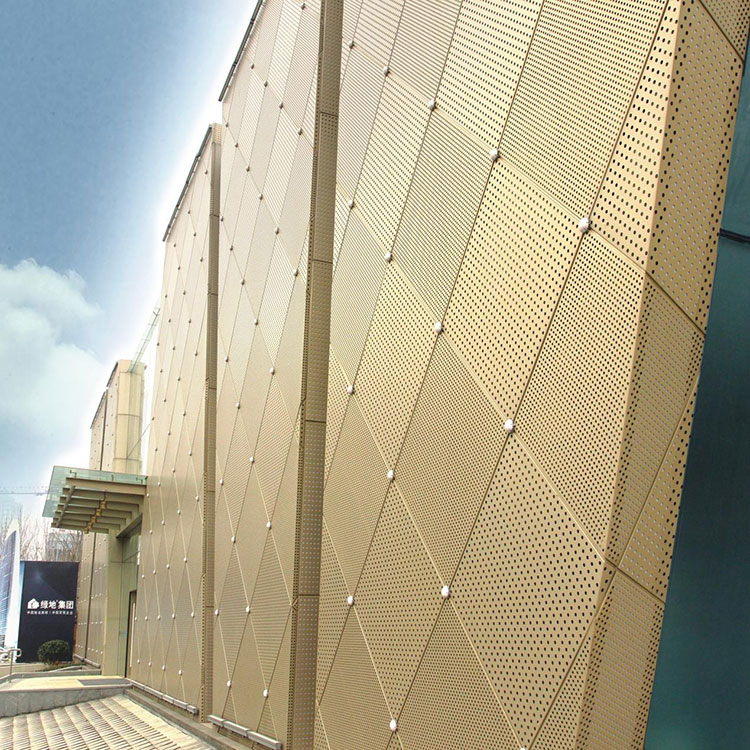The Benefits and Applications of Aluminum Wall Cladding
2025-03-04
In the world of architecture and construction, the materials used for building facades and exterior cladding have a significant impact on both aesthetics and functionality. Among the many materials available, aluminum wall cladding has gained immense popularity due to its durability, versatility, and modern appeal. In this blog, we will explore the advantages of aluminum wall cladding, its applications, and why it is a top choice for both residential and commercial buildings.
What is Aluminum Wall Cladding?
Aluminum wall cladding refers to the use of aluminum panels or sheets as a covering for the exterior walls of a building. This cladding is typically installed over the structural frame of a building, providing both protection and an enhanced visual appearance. Aluminum is a lightweight yet strong metal, making it an ideal material for wall cladding, especially in modern architecture where sleek, clean lines are often desired.
The aluminum panels used for wall cladding can come in various finishes, including smooth, textured, perforated, and even patterned, allowing for a wide range of design possibilities. The material is also available in different colors, which can either be powder-coated or anodized to achieve the desired look.
Key Benefits of Aluminum Wall Cladding
1. Durability and Strength
One of the main reasons aluminum wall cladding is so popular is its durability. Aluminum is highly resistant to corrosion, which makes it an excellent material for buildings exposed to harsh weather conditions such as rain, snow, and high humidity. Unlike other materials like wood or steel, aluminum does not rust, ensuring that the exterior of the building remains intact and looking new for many years.
Aluminum is also lightweight yet strong, which means it can withstand high winds, extreme temperatures, and other environmental stressors. Its resistance to warping or cracking further enhances its durability, making it a reliable option for both residential and commercial buildings.
2. Low Maintenance Requirements
Another significant advantage of aluminum wall cladding is its low maintenance needs. Due to its resistance to corrosion, aluminum does not require regular treatment or sealing, unlike wood or other materials that may need frequent repainting or recoating. A simple cleaning with water and mild detergent is often enough to keep aluminum cladding looking pristine.
This low-maintenance characteristic makes aluminum wall cladding an ideal choice for both building owners and property managers who want to reduce upkeep costs and ensure that their building maintains a professional appearance without continuous maintenance.
3. Energy Efficiency
Aluminum wall cladding can contribute to a building’s energy efficiency. Aluminum panels can be installed with insulation layers, which help to regulate the internal temperature of the building. In colder climates, this insulation helps keep heat inside, while in warmer climates, it can help to keep the interior cooler by reflecting heat away from the building.
Additionally, aluminum's reflective properties can reduce the need for artificial lighting by reflecting natural sunlight into the building. This energy-efficient quality can lead to lower energy costs and a more sustainable building.
4. Aesthetic Appeal
Aluminum wall cladding offers a modern, sleek, and clean appearance that enhances the aesthetic value of any building. The versatility of aluminum allows architects and designers to create a wide range of looks, from minimalist and contemporary to more intricate, textured finishes. The ability to use aluminum in different shapes, sizes, and colors makes it an excellent option for creating custom facades that align with the building’s design goals.
In addition to its visual appeal, aluminum cladding can be used to create unique patterns, perforations, and designs that allow for a more personalized touch. Whether it’s for a commercial building, residential property, or public infrastructure, aluminum cladding can elevate the building's appearance and help it stand out.
5. Sustainability
Aluminum is a highly sustainable material, and its use in wall cladding is an eco-friendly choice. Aluminum is 100% recyclable, meaning it can be reused multiple times without losing its properties. By using recycled aluminum, the environmental impact of production is greatly reduced, making it a greener alternative to other building materials.
Furthermore, the durability and low-maintenance nature of aluminum cladding means that the material's lifespan is long, reducing the need for replacements and minimizing waste. For those concerned with sustainability, aluminum wall cladding is an excellent choice for green building projects.
Applications of Aluminum Wall Cladding
1. Commercial Buildings
Aluminum wall cladding is widely used in commercial architecture due to its modern look, durability, and low maintenance. Office buildings, shopping centers, hotels, and public institutions often utilize aluminum cladding to create striking facades that reflect a professional and contemporary image. Aluminum’s versatility allows for creative and customized designs that cater to the specific needs of each commercial project.
2. Residential Buildings
In residential architecture, aluminum wall cladding is becoming increasingly popular for both new builds and renovations. Homeowners are drawn to its clean aesthetic, low-maintenance benefits, and energy efficiency. Aluminum cladding is particularly beneficial in climates with extreme weather conditions, as it provides reliable protection against the elements while maintaining the building’s appearance.
3. Industrial and Institutional Buildings
Aluminum wall cladding is also commonly used in industrial and institutional buildings, where durability and functionality are key. Factories, warehouses, schools, hospitals, and other public infrastructure benefit from aluminum’s strength and resistance to harsh environments. Aluminum cladding is able to withstand the challenges of industrial settings, including exposure to chemicals, pollutants, and extreme weather.
4. Interior Applications
While aluminum cladding is most commonly associated with exterior facades, it can also be used for interior applications. In commercial and residential buildings, aluminum can be used for feature walls, partitions, and other decorative elements. The ability to create sleek, polished surfaces makes aluminum an attractive choice for interior design.
Conclusion
Aluminum wall cladding is a versatile, durable, and aesthetically pleasing material that offers a range of benefits for both residential and commercial buildings. From its ability to withstand harsh weather conditions to its low maintenance needs and energy efficiency, aluminum wall cladding is an excellent choice for modern architecture. Whether you’re looking to improve the appearance of your building, reduce maintenance costs, or enhance its energy performance, aluminum wall cladding provides a practical and stylish solution. As sustainability becomes an increasing focus in the building industry, aluminum’s recyclable nature and long-lasting properties make it a material that aligns with both environmental and economic goals.



